| |||||||
 |
| Search this Thread |  91,757 views |
| | #1 |
| Distinguished - BHPian  Join Date: Aug 2014 Location: Delhi-NCR
Posts: 4,071
Thanked: 64,293 Times
| Indian Aviation - HAL Ajeet, the Folland Gnat Mk II. EDIT: 1965 war IAF documentary on page 6 Story of HAL Ajeet, the Gnat Mk II Background: In the 1950s the Indian Air Force (IAF) was getting its act together in the aftermath of independence with its resultant partition of the nation and the Air Force. The 1950s were also a time of great strides in aeronautical technology with many new concepts coming of age - swept wings, supersonic flight, turbojets, advances in aviation metallurgy and new combat doctrines to exploit these technologies to enhance our defense preparedness. In the mid-1950s the fighters and fighter-bombers we had were typically products of World War II - the legendary Spitfire, the de Havilland Vampire, an early jet and the Hawker Tempest which was the fastest piston engine powered operational aircraft. The only modern machine was a French jet the Dassault Ouragan called Toofani in IAF service. Fighters at this time were moving rapidly from being 400 knot subsonic machine gun equipped birds to 650knot transonic cannon equipped weapons (1 knot is 1 nautical mile per hour = ~1.85 kms per hour). In this milieu the IAF boldly decided to move to acquire a large fleet of a highly maneuverable transonic fighter that would also be built in India. To cut a long story short the Gnat was selected for its superb maneuverability, outstanding rate of climb (for that generation) and simplicity of design. Born, the Gnat: The Gnat was the creation of W.E.W. "Teddy" Petter, a brilliant if somewhat mercurial British aircraft designer of the Folland Aircraft Company, later acquired by Hawker Siddeley. Petter had earlier created the superlative Canberra bomber. Petter designed the Gnat to be a small, simple fighter that would offer the advantages of low purchase and operational costs and superlative maneuverability. One shortcoming of the Gnat was its limited internal fuel capacity which made permanent carriage of fuel drop tanks on the wing pylons a necessity. These however did not hamper maneuverability or climb rates. The Royal Air force (RAF) went on to buy the Gnat in its trainer variant and used it for 15 years as an advanced pilot trainer. The IAF became the main customer for the fighter variant. A license agreement was signed in 1956 whereby Folland supplied 25 fully built aircraft and 25 kits for assembly by HAL. HAL then went on to build many more with increasingly indigenous content for a grand total of 235 between 1959 and 1974. At their peak in the early 1970s the Gnat equipped no less than 8 IAF squadrons. A fighter squadron is typically 16 to 24 aircraft strong and is the basic fighting unit of most Air Forces around the world. Each squadron is made up of 4 to 6 flights of 4 aircraft each. This team of 4 fly together in a loose finger four formation when going into combat and cover each other's flanks and blind spots.  Gnat prototype in flight over UK, circa 1955 -- Copyright Mike Dowsing Collection 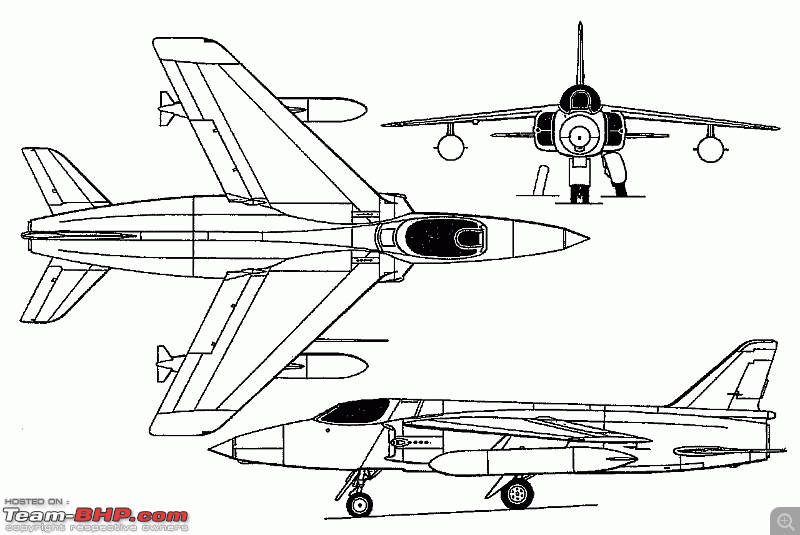 Gnat pencil outline. Note the relatively large shoulder mounted wings and permanent wing tanks to augment the limited internal fuel 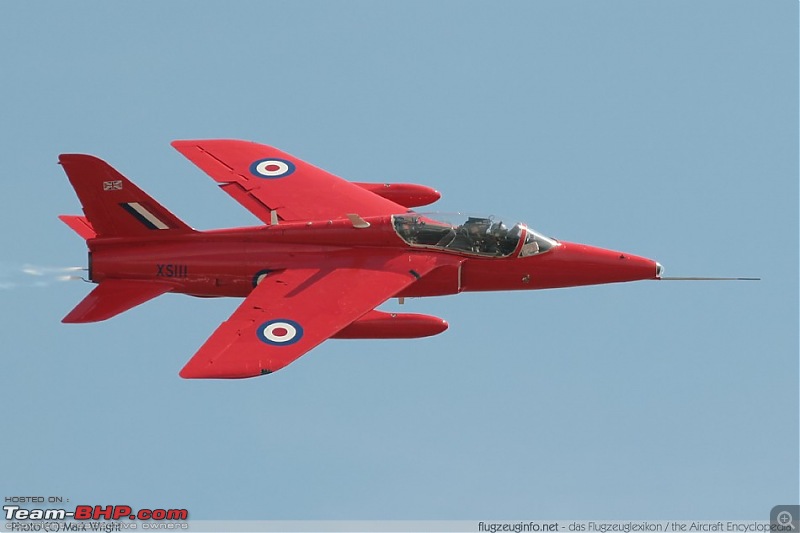 Gnat Trainer variant adopted by the RAF for advanced pilot training. It remained the RAF's main trainer till the mid-1970s. -- Copyright Mark Wright Nimble & Naughty: The Gnat was diminutive for a combat aircraft and remains to this day the smallest jet fighter to go into frontline service. At 29 feet 8 inches long it was the length of 2 Honda City's lined up back to back. With an empty weight of 2200 kgs it was lighter than some of the larger SUVs we drive around today. Its Rolls Royce Orpheus turbojet delivered 2118 kgs of sustained thrust at full power. A turbojet is an aviation turbine that likes to run at close to full power. It is by design at home with full thrust and high accelerations. It works best when throttled at 75% to 85% of capacity and is a gas guzzler at say 50% of capacity. The correct way to describe the power of a jet engine is in newtons but for simplicity the number is converted to kgs of thrust. While it is very difficult to convert kg thrust to horse power I will attempt it by extrapolating from aviation jet turbines which have been converted to marine ship propulsion variants where the kg to hp ratio comes to about 1:3. Not scientific but still a way to indicate in petro head language that you can think of the Gnat as having roughly 6400 hp engine (don’t beat me on this - just helping petroheads get an idea of scale!!) on a machine lighter than an Audi Q7. The Gnat's armament however was just adequate at 2 x 30mm Aden cannons with 115 rounds of ammo per gun firing at about 600 to 1200 rounds per minute per gun. The ammunition was adequate for about 3 full firings at an enemy aircraft. So if you were caught in the sights of a Gnat and the IAF pilot got off even a 1 second long burst you would find 20 to 40 30mm cannon shells coming your way. Each shell projectile weighs about 300 grammes, has a muzzle velocity of about 750 metres/second and carries the explosive charge of 2 grenades. The Gnat did not carry air to air missiles as didn’t many fighters of the day and it needed to carry fuel drop tanks on its 2 wing pylons to augment its flying endurance. 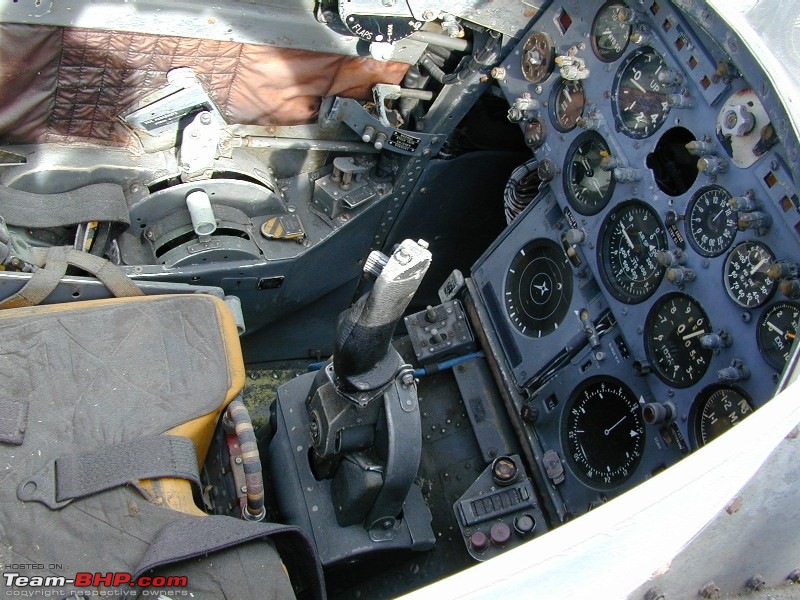 A well worn Gnat cockpit. The throttle is on the left and the flying stick in the centre. Gun firing button on stick. Note the simplicity of 1960s technology  Line drawing depicting airframe details. Guns are mounted on the intake lip centre with 4 ventilation holes behind. The small size of the aircraft can be gauged by the head of the pilot! Battle Honours: As most BHPians would know the Gnat acquitted itself with honours in the Indo-Pak wars of 1965 and 1971. In 1965 Squadron Leader Trevor Keelor became the first Indian jet fighter ace by shooting down a Pakistani F-86 Sabre Jet. Shortly thereafter, not to be outdone, his brother Denzil Keelor, who later rose to be an Air Marshall, also shot down a Sabre Jet. Trevor passed away in 2002; Denzil lives in Delhi after retirement. Over the 1965 and 1971 wars the Gnat came to be known as a Sabre slayer. The Sabre was considered by the West to be the top transonic (ie almost supersonic) fighter of its time but the superbly nimble Gnat and the skill of the IAF pilots outdid it. The Gnat's large wing gave it a low wing loading ie (all up weight)/(wing area) [see table below on technical specs]. The lower the wing loading the more maneuverable the aircraft. The Gnat also enjoyed a high power to weight ratio for its time of 0.6:1.0. Today the Sukhoi Su-30MKI of the IAF has a power to weight of 1:1. But for now back the 1960s. Most aerial combat takes place below 10,000 feet and in the speed ranges of 350 to 750 knots where it is not absolute speed but acceleration, tight turning and high rates of climb that count. In these parameters, though not supersonic, the Gnat excelled. Its climb rate at sea level was 20,000 feet per minute in an era where the best fighter bombers of the day climbed at 8000 feet/minute (Hawker Hunter), 9800 feet/minute (Sabre Jet), 8900 feet/minute (Dassault Mystere) and so on. It was the tightest turning combat fighter ever built and at subsonic speeds still is even today. The most famous Gnat pilot was Flight Lieutenant Nirmaljit Singh Sekhon who, taking off from Srinagar, single handedly took on 6 Sabre Jets that were attacking the IAF airbase knowing fully well that his chances of survival were slim. It is believed he shot down 2 Sabres and damaged a third before getting shot down himself. The ferocity of his attack encouraged the remainder three Pakistani pilots to flee from ths scene. His aircraft and body, sadly, were never found. He was awarded, posthumously, the Param Vir Chakra, the nation's highest award for valour. It took 6 Pakistani pilots to take on this one valiant Sikh. Several IAF pilots won victories against Pakistani Sabre Jets. Some names are - Bharat Singh, Roy Andrew Massey, MA Ganapathy, Donald Lazarus, AK Mazumdar, Vinay Kapila, VS Pathania.....the nation owes its gratitude to these men who came from all parts of India. 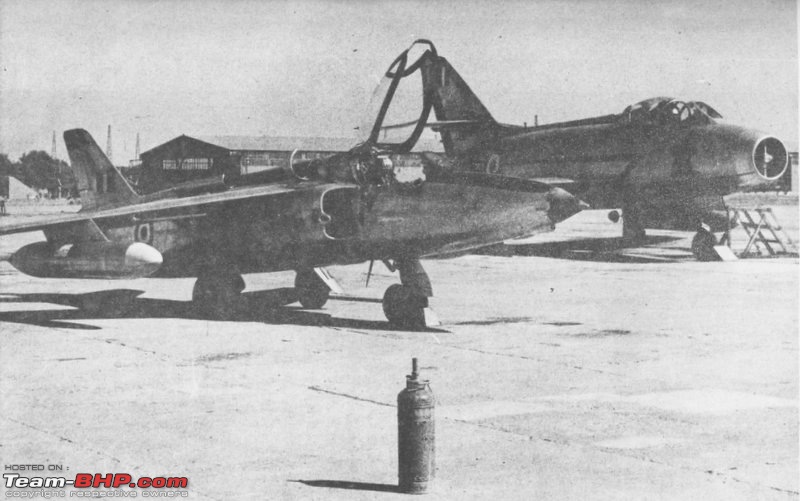 1965 War, Western Sector. Gnat in foreground and Mystere fighter-bomber in the background -- Source Bharat Rakshak.com  Squadron Leader Denzil Keelor who shot down a Pakistani Sabre Jet in September 1965. Photo taken soon after his victory -- Source Bharat Rakshak.com But there were kinks: But the Gnat was not without its problems. Being built so small it was tightly packed leaving inadequate room for controls and hydraulics and most importantly redundancy. As a consequence reliability in the pre-1965 era suffered. The IAF and HAL painstakingly ironed out the kinks one by one with some support from the parent design bureau in the UK. 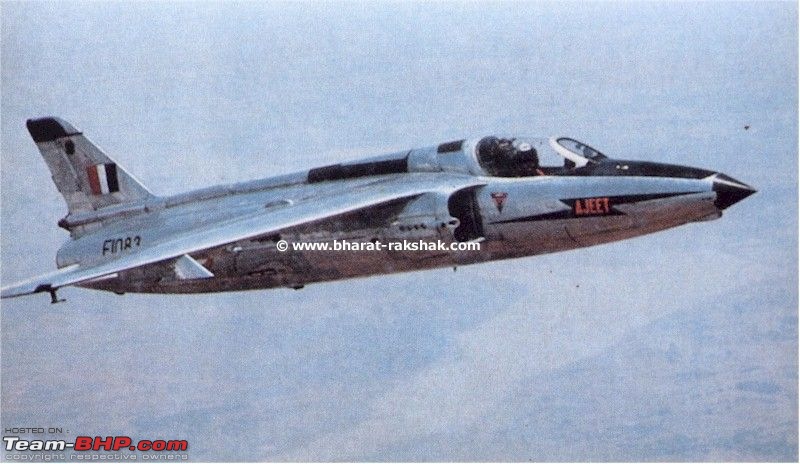 HAL Ajeet is born. First flight of the Ajeet prototype in March 1975 -- Source Bharat Rakshak.com 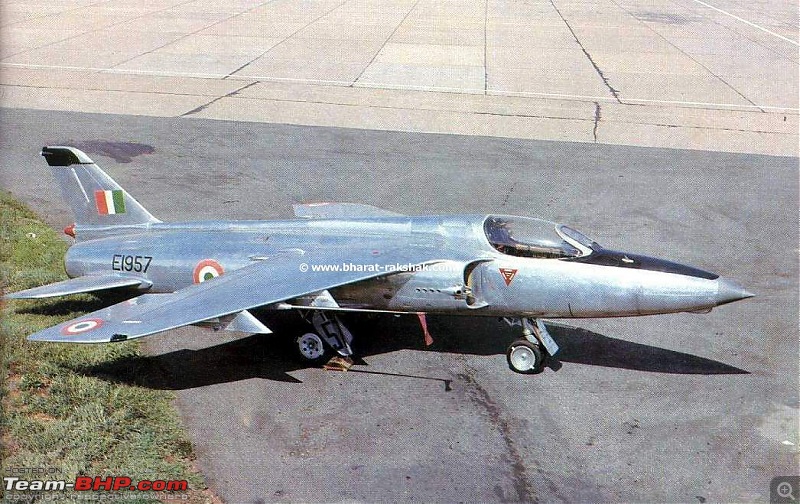 Ajeet on tarmac at HAL Bangalore, circa 1976 around the time it entered service Ajeet, Development: In around 1970 the IAF and HAL then decided to improve on a proven product and develop the indigenous Gnat Mk II christened the Ajeet (Unconquerable). Sensibly they decided to go step by step and develop a reasonably improved product and get it ready in time. HAL modified the final two Gnats on the production line as prototypes for the Ajeet, with the first one flying on 6 March 1975, with the second following on 5 November, 1975. Testing proved successful and the first production Ajeet flew on 30 September 1976.  Ajeet, armament options - from front to back - 68mm Matra rockets, 30mm shells in centre , bomblet dispensers on L and R, 500lbs iron bombs centre, drop tanks L&R, Matra rocket pods on wing pylons --- Source Bharat Rakshak.com Ajeet, design improvements: The changes from the original Gnat were considerable. They included: 1. Wet wing tanks. This means the hollow of the wings was sealed and plumbed to carry fuel. In case of the Gnat about 250 litres in each wing. This greatly enhanced the aircraft's range and freed its wing pylons for weapons. This was the most important improvement of all. 2. The number of hardpoints or pylons under the wings were increased from 2 to 4 (2 on each wing). A pylon is a hard point usually under a wing on which weapons and fuel tanks or other electronic recce devices can be carried. The 4 pylons gave the Ajeet a much needed flexibility of weapons that could be carried. 3. These pylons could then be fitted with 68mm rockets, 57 mm rockets, 227 kgs (500 lbs) iron bombs, 113.5 kgs (250 lbs) bombs, and similar unguided weapons for the air-to-ground role. 4. Improvements to the hydraulics and control systems (these had been a source of difficulties in the Gnat) 5. Fitting of improved Martin-Baker GF4 ejection seats which allowed the pilot to eject with a 0/0 state ie zero height, zero forward speed 6. A new Ferranti ISIS gunsight to improve its gun fighting accuracy 7. The addition of slab tail control surfaces also known as a flying tail. In this the horizontal tail wings at the aft of the aircraft are all moving aerodynamic surfaces. They pivot fully around their aerodynamic centre rather than their gravitational centre. This helps in both maneuverability and stability at high speeds. 8. Improvements to the landing gear to take slightly higher all up weights Visually, the Ajeet appears similar to the Gnat with the presence of two extra hardpoints being the only obvious distinguishing features from the older aircraft. Internally, as the reader can see, it was a significantly different aircraft. The one improvement I wish they had made would have been to mate the Ajeet with the French Matra infra red air to air missile or the Soviet equivalent. I don't believe this was done. With such a combination the Ajeet would have been unbeatable in a dogfight. Ajeet, In service: The Ajeet entered service with the IAF in 1977, about 90 were built bringing the Gnat/Ajeet total to 325. The Ajeet retained all the nimbleness of the Gnat along with better endurance and the multi-role flexibility of being able to act in the ground support role in addition to air defence. The Ajeet served with distinction till 1991 completing 32 years of front line service since the first HAL assembled Gnat flew in November 1959. HAL and the IAF did not go in for a improved version of the Ajeet as they had extracted what could be done within the limits of the airframe size and weight. The diminutive airframe did not have the volume inside for modern electronics (called avionics in aeronautics) such as radar, electronic guidance equipment, electronic warning and counter measures equipment and modern navigation-attack suites. HAL developed a prototype of an advanced pilot trainer based on the Ajeet airframe and tested it a few times. It did not prove satisfactory and the project was buried. At one time there was talk of developing a navalized variant of the Ajeet for the Indian Navy's venerable carrier INS Vikrant. Vikrant's steam catapult that launches the aircraft off the deck into the air needed the aircraft being launched to have a minimum weight of 10,000 lbs about 10% more than the all up weight of the Ajeet. So that thought got shelved. The Ajeet gave India an indigenously developed aircraft with excellent light fighting qualities that could be built at a reasonable cost without consuming too much of then scarce forex resources. That the Ajeet and the Gnat served the country so well and for so long is a testimony to W.E.W. Petters design ingenuity, HAL's skill at indigenization and the valour of pilots like Sekhon, Keelor and a host of other patriotic men.  Ajeet squadron at a forward airbase, circa 1980s -- Source Bharat Rakshak.com  Ajeet trainer prototype which did not enter production  Ajeet, more air to ground weapon options. Can't carry all options simultaneously. These options gave the Ajeet a useful ground support attack role which the Gnat was not capable of. Technical Data Design approach The Design philosophy of the Ajeet, which it inherited from the Gnat was to fit the most powerful light engine into the smallest airframe and fit the biggest low aspect ratio wings to that combination. The engine to airframe fit was to obtain the best power to weight ratio and hence acceleration and climb. The biggest wing was to get the lowest (ie best) wing loading to aid combat maneuverability. The wing design was swept to obtain the highest possible Mach number for a given power to weight ratio. As you see from the data below the Ajeet had a power to weight ratio of 0.6:1.0 and a wing loading in clean conditions of 278kgs/ sq metre both of which figures were class leading for the early 1960s and still very good for the 1970s when the Ajeet entered service. Dimensions Crew: 1 Length: 9.04 m (29 ft 8 in) Wingspan: 6.73 m (22 ft 1 in) Height: 2.46 m (8 ft 1 in) Wing area: 12.69 m² (136.6 ft²) Aspect ratio: 3.56 [in aerodynamics, aspect ratio is the ratio of the wing length to its breadth. An unswept thin wing of a typical transport aircraft will have a high aspect ratio while a fighter's swept wing, looking almost like a triangle, will have a low aspect ratio. Aspect ratio influences, lift, angle of stall, take off speeds, rate of roll acceleration and (in combination with other factors) maneuverability. There is no good or bad in aspect ratios - you design the wing depending on what the role of the aircraft is. the Ajeet's aspect ratio is on the lower side reflecting its combat role] Weights Empty weight: 2,200 kg (4850 lbs) Loaded weight: 3,539 kg (7,803 lbs) clean take-off weight Max. takeoff weight: 4,173 kg (9,200 lbs) [this means the aircraft is loaded with whatever goes inside the airframe with nothing hanging on the pylons or centreline hardpoint. in case of the Ajeet it was the fuel, the 230 rounds of 30mm ammunition and the weight of the pilot that took it to its clean weight] Powerplant: 1 × HAL/Bristol Siddeley Orpheus 701E turbojet, 2118 kgs maximum sustained thrust. [later Rolls Royce acquired Bristol Siddeley] Performance Maximum speed: 1,152 km/h (622 knots) at sea level i.e. 320 meters/ second [the Ajeet could exceed Mach 1.0 in a shallow dive. Mach 1 is the speed of sound approximately 1235 kmph at sea level. It varies with density and temperature and reduces as the altitude increases. At sea level most supersonic fighters too barely exceed the speed of sound and if fully loaded are firmly transonic ie flying just below the speed of sound say at Mach 0.9. The Ajeet's transonic speed should be viewed in this context - that at low altitudes where most combat takes place it could hold its own.] Service ceiling: 45,000 ft (13,720 m) combat; 52,000 feet absolute Combat radius: 190 km (100 nm) lo-lo-lo with two 250 kg bombs or two pods of 18 x 68mm rockets each; 1900 kms (1025 nm) ferry range with drop tanks hi-hi-hi. [lo-lo-lo is the typical fighter bomber flight configuration it means ingress, attack and egress are all at low altitudes typically below 500 feet to avoid radar detection; similarly you can have flight configurations such as lo-lo-hi or hi-lo-hi. Ferry flights by nature will be hi-hi-hi to get the best fuel economy] Wing loading: 278 kg/m2 at clean weight (57 lb/ft²) or 328kg/m2 at all up weight (67 lbs/ft2) [to give the reader an idea of how lightly loaded the Ajeet wing was, ie geared for sharp maneuvering, compare it to the 88lbs/ sq feet of the vaunted F-16 in clean conditions] Climb: Initial climb 20,000 feet/minute; time to 12,000 m (39,375 ft) 5 minutes in clean configuration Power to Weight Ratio: 0.6:1.0 at clean take off weight; 0.51:1.0 at maximum take off weight Armament Guns: 2× 30 mm ADEN cannons with 115 rounds each Weapons: Up to 1985 lb (900 kg) of external stores on four underwing hardpoints. Types of weapons usually carried would be - 68mm rocket pods; iron bombs - 227 kgs, 113.5 kgs; napalm bombs Sources/References: The World Guide to Combat Planes by William Green, 1966 edition, MacDonald & Co Modern Fighting Aircraft by Bill Gunston, Salamander Books 1984 The Observers Book of Aircraft by William Green, 1977 edition & 1964 edition, Frederick Warne & Co Ltd The History of Indian Aviation by Pushpinder Singh, The Society of Aerospace Studies, 2003 The Indian Air Force and its Aircraft, 1932 -82, Golden Jubilee Edition Last edited by ajmat : 6th November 2014 at 21:10. |
| |  (60)
Thanks (60)
Thanks
 |
| The following 60 BHPians Thank V.Narayan for this useful post: | ajmat, amit_purohit20, anilntny, ankan.m.blr, arsenal.arun, ashpalio, audioholic, av8er, BackInTheFold, carrazy, Crazy_cars_guy, createrkid, DeClutch 4X4, deoelect, dreamseller, d_himan, greenhorn, GTO, gurudutt, honeybee, Insearch, iron, jalsa777, Joe M, karlosdeville, kaustubh_vaze, ksmrsm, mac187, mallumowgli, mashmash, mnvvishwa, mobius 1, moralfibre, mpksuhas, Mr.Boss, navin, Puneet.S, R2D2, Rehaan, Ricci, Rudra Sen, rulerofsun, sadnabrina, Santoshbhat, Shreyans_Jain, SnS_12, somjith_nair, speed kills, sridhar-v, SS-Traveller, Steeroid, sudev, Technocrat, Teesh@BHP, tejas.negandhi, The Observer, tsk1979, unni.ak, Vasuki, W.A.G.7 |
| |
| | #2 |
| Team-BHP Support  | re: Indian Aviation - HAL Ajeet, the Folland Gnat Mk II. EDIT: 1965 war IAF documentary on page 6 Note from Mod Going live - Thanks for compiling and sharing an important feat of our Air Force |
| |  (2)
Thanks (2)
Thanks
 |
| The following 2 BHPians Thank ajmat for this useful post: | F150, GTO |
| | #3 |
| BHPian Join Date: Nov 2009 Location: Bangalore
Posts: 200
Thanked: 169 Times
| Wonderful compilation, a book recommendation for the lovers of aviation and history, "not much of an engineer" is an autobiography of sir Stanley hooker, a mathematician who went to design historic engines. |
| |  (1)
Thanks (1)
Thanks
 |
| The following BHPian Thanks bullock-Car for this useful post: | V.Narayan |
| | #4 |
| BHPian Join Date: May 2011 Location: India
Posts: 333
Thanked: 300 Times
| re: Indian Aviation - HAL Ajeet, the Folland Gnat Mk II. EDIT: 1965 war IAF documentary on page 6 Wonderful article! Can you also add the part where the designer nearly refused to cooperate with the IAF since he thought that India was a communist nation :-) . A small correction in the interest of historical accuracy: Neither Sekhon nor Trevor Keelor succeeded in shooting down any PAF planes. The first IAF pilot to draw blood was Pathania. The Battle over Boyra was the Gnat's prize day! |
| |  ()
Thanks ()
Thanks
 |
| | #5 | |
| Senior - BHPian Join Date: Oct 2005 Location: Faridabad/Delhi
Posts: 1,703
Thanked: 780 Times
| re: Indian Aviation - HAL Ajeet, the Folland Gnat Mk II. EDIT: 1965 war IAF documentary on page 6 Quote:
http://ajaishukla.blogspot.in/2014/0...-happened.html In a bizzare incident during the 1965 Indo-Pak war, an IAF Gnat was landed in Pakistan by an IAF pilot named Sqn Ldr Brij Pal Singh Sikand who was captured and made prisoner of war. Pakistan handed him over to India after 5 months. However, he wasn't removed from service - the well-connected guy went on to become an Air Marshal! Details of the incident available here: http://defence.pk/threads/f-104-the-...5.53891/page-2 The captured Gnat remains on display in PAF museum at Karachi. Here's a pic: | |
| |  (3)
Thanks (3)
Thanks
 |
| The following 3 BHPians Thank directinjection for this useful post: | ashpalio, createrkid, R2D2 |
| | #6 |
| BHPian Join Date: May 2011 Location: India
Posts: 333
Thanked: 300 Times
| re: Indian Aviation - HAL Ajeet, the Folland Gnat Mk II. EDIT: 1965 war IAF documentary on page 6 Agree with the Sikand fiasco being unforgivable. On the other hand, the blog by Ajay shukla is riddled with errors. It is almost as if he has an axe to grind with the IAF. Please read Jagan and Sameer Chopra's excellent book on the 1965 air war. The performance of the PAF wasn't half as good as they claim, nor was the performance of the IAF half as bad. Last edited by john doe : 7th November 2014 at 11:51. |
| |  ()
Thanks ()
Thanks
 |
| | #7 |
| BHPian Join Date: Oct 2012 Location: Pune (1-4 DND)
Posts: 509
Thanked: 419 Times
| re: Indian Aviation - HAL Ajeet, the Folland Gnat Mk II. EDIT: 1965 war IAF documentary on page 6 Thank you for bringing us all this very interesting piece of our history. Its a pity our education system does not tell us about these valiant acts and amazing technology in the country, else some of us would have scored better marks in History as a subject. |
| |  (1)
Thanks (1)
Thanks
 |
| The following BHPian Thanks latentpotential for this useful post: | ashpalio |
| | #8 |
| BHPian Join Date: Feb 2013 Location: Mumbai
Posts: 344
Thanked: 505 Times
| re: Indian Aviation - HAL Ajeet, the Folland Gnat Mk II. EDIT: 1965 war IAF documentary on page 6 Thanks for compiling and bringing up this thread. I was very interested in IAF and its aircrafts since a long time, hence my choice of my handle. One thing to note is that, HAL developed the Ajeet in good time but it took them so long to develop LCA. Of course, lack of funding, no political will and technology transfer issue all plagued HAL from time to time. But looking at history, HAL has the wherewithal to make world class aircraft. It is about time that they come up with advanced technology fighters and give tough competition to those Dassaults, Typhoons, Eurofighters etc. Why can't all such govt organisations be like ISRO?? |
| |  ()
Thanks ()
Thanks
 |
| | #9 | |
| BHPian Join Date: Nov 2008 Location: Pune
Posts: 809
Thanked: 1,177 Times
| re: Indian Aviation - HAL Ajeet, the Folland Gnat Mk II. EDIT: 1965 war IAF documentary on page 6 Quote:
The fuel consumption of all gas turbine engines is poor at idle and low RPM, not just this one. Beyond that, the fuel consumption varies depending on bypass ratios and inlet effficiency, as well as allowable combustion temperature. I'm a little suspect on the 50% part though, as I gather most engines idle at around 60% RPM. The RPM vs thrust curve must be very steep rather than linear, else the fuel efficiency would go very high. Pretty much all supersonic fighters can go supersonic at sea level in clean and lightly loaded condition, it's the high ordnance loads that prevent supersonic flight at low altitude. Some jets, like the F-16 and Su-30 are limited at low altitude not by thrust but airframe stress. The F-16 and Su-27/30 are both said to hit 800 knots, with the throttle not fully open. That said, airframe optimization as per mission profile does affect performance , I have read of F-15 pilots having a hard time keeping up with Buccaneers on low altitude penetration missions, even though they were not going supersonic. I surmise it's because to go any faster, the F-15 would require using the afterburner for extended duration, risking running out of fuel. As for agility, I'd like to know if you came across any turn rate and turn radius figures. | |
| |  ()
Thanks ()
Thanks
 |
| | #10 |
| Distinguished - BHPian  Join Date: Jan 2008 Location: Gurgaon
Posts: 3,838
Thanked: 3,179 Times
| re: Indian Aviation - HAL Ajeet, the Folland Gnat Mk II. EDIT: 1965 war IAF documentary on page 6 Excellent read. Thanks for compilation and enlightening us. I was a small child during the 1965 Pakistan war and use to hear stories of IAF pilots and their valour from from my father and uncles. Memories refreshed. |
| |  (1)
Thanks (1)
Thanks
 |
| The following BHPian Thanks sudev for this useful post: | R2D2 |
| | #11 | |||
| Distinguished - BHPian  Join Date: Aug 2014 Location: Delhi-NCR
Posts: 4,071
Thanked: 64,293 Times
| re: Indian Aviation - HAL Ajeet, the Folland Gnat Mk II. EDIT: 1965 war IAF documentary on page 6 Quote:
Quote:
Quote:
A big thanks to Ajmat who very kindly took time out and helped me with the photos and formatting.  | |||
| |  (1)
Thanks (1)
Thanks
 |
| The following BHPian Thanks V.Narayan for this useful post: | R2D2 |
| |
| | #12 |
| BHPian Join Date: May 2009 Location: NYC / Lucknow
Posts: 613
Thanked: 3,498 Times
| re: Indian Aviation - HAL Ajeet, the Folland Gnat Mk II. EDIT: 1965 war IAF documentary on page 6 Was Surprised to see this type of thread on Team-Bhp. I usually surf other forums for these type of threads  However the First Post is filled with historical inaccuracies regarding the 65 and 71 war. Some examples are: "In 1965 Squadron Leader Trevor Keelor became the first Indian jet fighter ace by shooting down a Pakistani F-86 Sabre Jet. " This is false, an Ace is Pilot who has shot down 5 or more enemy aircraft. No Post Independence IAF pilot has done this. Indra Lal Roy was an Indian born Ace during the World War 1, but he fought for the British. The story about Flight Lieutenant Nirmaljit Singh Sekhon although inspiring, has been exaggerated quite a bit. He managed to damage some enemy aircraft before being shot down, he didn't shoot down any. Before the HAL Ajeet, there was the HF-24 "Marut" HF = Hindustan Fighter. It was the first combat jet designed in India (although by a German Designer) and it first flew in 1961. |
| |  (5)
Thanks (5)
Thanks
 |
| The following 5 BHPians Thank Foxbat for this useful post: | ashpalio, BackInTheFold, createrkid, john doe, Santoshbhat |
| | #13 | |
| Senior - BHPian Join Date: Sep 2014 Location: Chennai
Posts: 4,952
Thanked: 9,155 Times
| re: Indian Aviation - HAL Ajeet, the Folland Gnat Mk II. EDIT: 1965 war IAF documentary on page 6 Calling Kurt Tank just "a german designer" is like calling Enzo Ferrari "an Italian designer" but I digress. I do wish HAL had worked with the marut platform and evolved it further to build a ground attack fighter of the A10 warthog class. About aces - Very well made point, you near me to it. Indra Lal "Laddie" Roy was the one ace we can sort of lay claim to. His nephew Subroto Mukherjee did follow in his footsteps to become the first Indian COAS of the IAF. Quote:
| |
| |  ()
Thanks ()
Thanks
 |
| | #14 |
| Senior - BHPian | re: Indian Aviation - HAL Ajeet, the Folland Gnat Mk II. EDIT: 1965 war IAF documentary on page 6 Thank you for tingling my childhood memories with this epic fighter. I distinctly remember how 3 of our Gnats shot down 3 PAF Sabre jets before the 1971 war began. One of the pilots, R Massey hailed from Cuttack and all of us were talking about his achievement in school. His nephew was a year junior to me in school, and his brother Leslie was a family friend. The Gnat was one of our most versatile fighters. It could take turns at a very short radius and blast the allegedly superior Sabres to smithereens. So nice to read this wealth of information. |
| |  ()
Thanks ()
Thanks
 |
| | #15 | |||
| Distinguished - BHPian  Join Date: Aug 2014 Location: Delhi-NCR
Posts: 4,071
Thanked: 64,293 Times
| re: Indian Aviation - HAL Ajeet, the Folland Gnat Mk II. EDIT: 1965 war IAF documentary on page 6 Quote:
Quote:
Quote:
 ) as my neighbor. ) as my neighbor. | |||
| |  (6)
Thanks (6)
Thanks
 |
| The following 6 BHPians Thank V.Narayan for this useful post: | ABerry, aditya101, ashpalio, Foxbat, Kool_Kid, vnabhi |
 |


